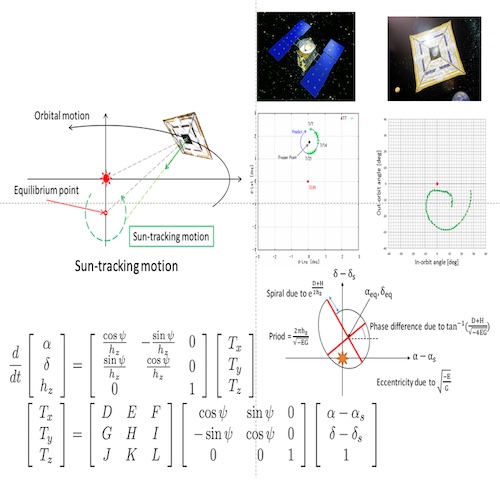Back to List
Attitude Control under Solar Radiation Pressure

本研究では,宇宙機に作用する太陽放射圧(SRP)のモデリング技術に焦点を当て,非等方的な反射特性を持つ一般的な表面を組み込むことができる.SRPトルクは,特に深宇宙ミッションにおいて宇宙機の姿勢に大きな影響を与える.SRPトルクは宇宙機の形状や姿勢だけでなく,宇宙機表面の光学的反射特性にも依存する.本論文の目的は,双方向反射分布関数(BRDF)の測定により,正確な反射分布モデルを作成することである.BRDFはもともとコンピュータグラフィックスの分野で開発された技術であり,任意の入射光線と射出光線の間の反射率マップを一般的な数学形式で記述する.
This research focused on a modeling technique of the solar radiation pressure (SRP) exerted on spacecraft which can incorporate general surface with anisotropic reflectance property. The SRP torque is a major disturbance for the attitude of spacecraft especially in deep space missions. It depends not only on the shape and attitude of spacecraft, but also on their surface optical reflectance property. The aim of this paper is to create a precise reflectance distribution model by measurement of a bidirectional reflection distribution functions(BRDF). A BRDF, a technique originally developed in the field of Computer Graphics, describes a reflectance map between arbitrary incident and emitted rays in a general mathematical form.
Abstract
SRPトルクは,特に深宇宙ミッションにおいて,宇宙船の姿勢にとって大きな外乱となる.これは宇宙船の形状や姿勢だけでなく,表面の光学反射特性にも依存する.一部のミッションでは,SRPを補正するのではなく,SRPを利用して宇宙船の姿勢を安定させ,方向転換を試みている.JAXAのソーラーセイル技術実証機「イカロス」と小惑星探査機「はやぶさ2」がその代表的なミッションである.彼らは,探査機本体に作用するSRPトルクを非常に精密にモデル化し(GSDM:Generalized Solar-sail Dynamics Model),探査機の姿勢制御に有用な挙動を抽出することに成功した.一方,「IKAROS」や「はやぶさ2」の運用では,精密なSRPモデリングにより,GSDMで用いられている従来のSRPモデルから推定されるSRPトルクと実際の飛行データとの間に,少なくとも3%の方向不整合が見つかっている.
我々の詳細な感度解析により,この誤差は太陽電池アレイパネル(SAP)のような宇宙船上の広い領域の非等方的な光学的反射率に起因していると予想される.そこで本研究の目的は,双方向反射分布関数(BRDF)の測定により,正確な反射率分布モデルを作成することである.BRDFは,もともとコンピュータグラフィックスの分野で開発された技術で,任意の入射光線と射出光線との間の反射率マップを一般的な数学形式で記述します.
はやぶさ2に搭載されるSAPのテストセルに対してBRDF測定を行った.その結果,従来のモデルではモデル化されていなかった特徴的な異方性反射特性が見出された.また,この再反射は太陽電池の微細構造に起因するものであることが示唆された.そして,BRDF測定で観測された異方性の特性を再現する,コンパクトな再反射の数学モデルが開発された.このモデルは,従来のSRPトルクと飛行データとの間の矛盾をうまく説明し,材料の微視的構造と光学特性とを関連付ける.
The SRP torque is a major disturbance for the attitude of spacecraft especially in deep space missions. It depends not only on the shape and attitude of spacecraft, but also on their surface optical reflectance property. Some missions even attempted to exploit the SRP to stabilize and reorient spacecraft attitude rather than compensating it. Two such typical missions are the JAXA’s solar sail technology demonstration spacecraft IKAROS and the asteroid explorer Hayabusa2. They modelled very precise SRP torque exerted on the spacecraft bodies (GSDM: Generalized Solar-sail Dynamics Model) and successfully extracted a useful behavior to control the spacecraft attitude. On the other hand, owing to precise SRP modeling used in the operation of IKAROS and Hayabusa2, at least 3% of directional inconsistency has found between the SRP torque estimated from the conventional SRP model used in the GSDM and the actual flight data.
Our detailed sensitivity analysis implies the error si supposed to be due to unmodelled anisotropic optical reflectance of a large area on the spacecraft, such as solar array panels (SAPs). Therefore, the aim of this research is to create a precise reflectance distribution model by measurement of a bidirectional reflection distribution functions (BRDF). A BRDF, a technique originally developed in the field of Computer Graphics, describes a reflectance map between arbitrary incident and emitted rays in a general mathematical form.
The BRDF measurement was performed for test cells of the Hayabusa2 SAPs. As a result, a distinctive anisotropic reflectance property was found which hadn’t been modelled in the conventional model. It was also suggested that this reflection should be due to the microscopic structure of the solar cell. Then a compact mathematical model of the reflection which reproduces the anisotropic property observed in the BRDF measurement has been developed. This model successfully describes the inconsistency between the conventional SRP torque and the flight data and relates material’s microscopic structure to the optical property.